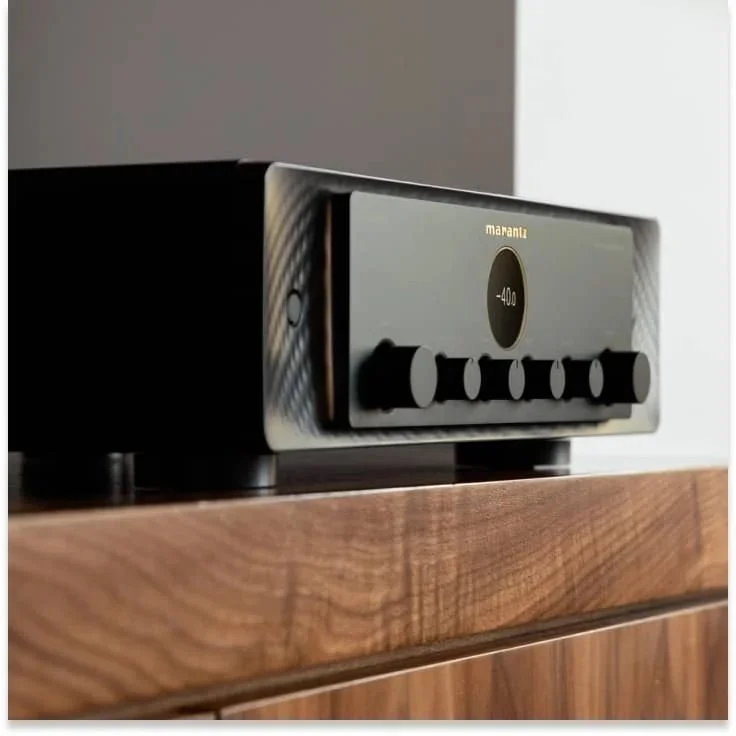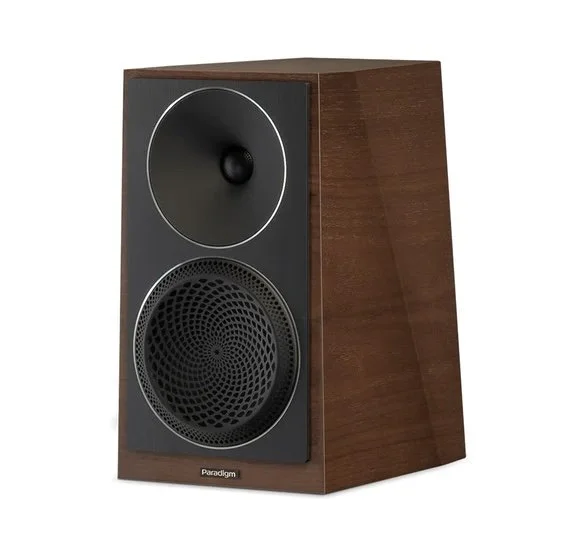Marantz Model 40n Integrated Streaming Amplifier
There is an audiophile mystique around Japanese high-end audio equipment, especially the aesthetic and sound of super high-end components and cartridges (but not speakers, oddly enough) from companies such as Shindo, Air Tight, Accuphase, Phasemation, Koetsu and Miyajima Labs, among others. All well-founded in my opinion—superb gear with unique, wonderful sounds. Also, more mainstream manufacturers such as Marantz, Yamaha, Technics, Audio Technica and Luxman possibly have less mystique, but in reality, they continue to be wildly popular with young audiophiles. When I mentioned the Marantz Model 40n Integrated Streaming Amplifier ($2499) was on the schedule, I knew I’d get an excited reaction from the young guns on our staff. And did!
Beyond the internet hype, one of the reasons for the youthful FOMO is the very limited availability of equipment to audition since the pandemic and logistical issues. Other reasons, other than affordable good sound, I don’t get it. I don’t have the vintage vibe gene.
For too long, getting mainstream Japanese gear for review has been almost impossible. Happily, Audio Technica and Technics are in the works but sadly three approaches each to Yamaha, Luxman and Accuphase (stop press—something possibly, maybe…) were unsuccessful due to a lack of inventory. Also, a good friend cancelled a Luxman phono stage order after a six-month delay dragged past a year. A shame as Luxman gear has such a good reputation for sound.
Staff members tell me about the allure of vintage equipment. Hey, I’ve lusted after vintage tube amps the same as anybody, and I’ve wanted classic Idler drive turntables, too. But in the end, I’m a new technology, parts and design type of guy.
Another reason many young audiophiles love Marantz and Yamaha gear is the quality of the ‘60s and ‘70s models and the memories of great audiophile times past. Especially as they can often afford the used gear in question. I think we’ve all owned (or will own) a Yamaha or Marantz integrated at some point in our lives
My Use
The Marantz 40n (the “n” stands for “network”) does not look like other Japanese integrated amps, vintage or modern. A lovely two-level faceplate, with smallish (plastic?) knobs and a small porthole screen. Notice, no VU meters which are catnip for a specific type of audiophile. I can take them or leave them, but for some of our guys, it’s eye-bulging love time. The single “porthole” features on/off animated visuals and a detailed alphanumeric display.
Before I continue, I’d like to thank our good friends at Atlas Audio Video here in Victoria for the use of the Marantz 40n. Nowadays, editors in our business have to go to the dealer for this type of missing-in-action equipment.
For the price of $2499, I wanted to pair the 70W Class A/B 40n with like-minded gear. I went with Audioquest cables, a Dual CS 618Q Manual HiFi Turntable and two bookshelf loudspeakers, the Totem Acoustic Bison and Paradigm Founder 40B (both reviews forthcoming). The single subwoofer pre-out making a sub an easy option went unused. A 10K system, inspirational and aspirational for those getting into or continuing their high-end audio journey.
Much like the Naim NSC 222 I reviewed a few weeks back, the Marantz 40n includes an analogue preamp with analogue inputs and a network DAC/streamer with digital controls. And also has a Class A/B amplifier section (using HDAM modules with four output devices per channel used in parallel—70W (8ohm) and 100W (4ohm).
There are enough modern lifestyle inputs/outputs to give you flexibility with two channels and home theatre including 3x line-level analogue, 1x power amp (bypass), MM phono, optical digital, coaxial digital, USB-A, HDMI ARC, Ethernet, Wi-Fi, remote in and Bluetooth (surprisingly, only SBC Codec). Outputs include line-level out, subwoofer pre-out, speakers out and remote out.
I used the stock IEC power cord. I did not test the dedicated headphone output. Playback was in “source direct” mode—tone and balance controls off.
As the 40n is not yet Roon Ready (Roon tested, so, imminent?), I used Marantz’s native HEOS app for streaming. Functionality and stability. HEOS playback is up to 24-bit/192kHz PCM and DSD up to 5.6MHz and includes a multiroom feature.
Natively, the HEOS app accesses Spotify, Tidal, Amazon Music, Deezer and the main internet radio channels. No native joy on Apple Music and Qobuz—which can be cast from another device to the 40n via UPnP or using AirPlay 2.
HEOS app front page.
Features and Specifications
Power Transformer: Double Shielded Toroidal
Frequency Response: 5Hz - 50kHz
Total Harmonic Distortion: 0.02% (20Hz - 20kHz, 8Ω)
Input Sensitivity/Phono input: 2 mV / 47 Ohm
Input Sensitivity/CD/Line/Recorder: 220 mV / 20 Kohm
Input Sensitivity/Power Amplifier input: 1.6 V / 15 Ohm
SN Ratio PHONO/(MM): 87dB; CD: 106dB
Ext. Pre Input (Power Amp Direct): yes
Preout: no
Dimensions (W x H x D in inches) 21" x 10" x 20.6"; Weight: 17 kg
As you can tell by the features, this integrated streaming amplifier is the epitome of an all-in-one. And all for $2499. Plug in speakers (and a turntable, if you wish) and off you go. There must be a catch, right? Let’s find out.
Sound
In general, the sound is beefy and the 40n drove both small speakers easily (and the much larger Paradigm Persona 3H Loudspeakers). There is comfort in the sound and also in the ease of use. I’d categorize the sound on the warmer side of neutral with solid, deep bass reflecting the same warmer, “rounder “ (not soft-edged) performance. In the here and now, there are many companies producing all-in-ones or almost all-in-ones for reasonable prices and with some serious legacy behind them. There are few companies with as much audio history as Marantz but the 40n is far from the Marantz receiver designed by Saul Marantz I owned 40 years ago.
So it’s easy to recommend this streaming integrated amplifier over others at this price point on functionality, looks and feel, but what about sound?
Marantz supplies a solid, comprehensive remote. Additionally, you can use the app for navigation/volume or voice control from Google or Alexa, or Siri via AirPlay.
I threw the 40n in the deep end as we began serious auditioning. The Firebird by Stravinsky (Mercury vinyl reissue/LSO/Dorati) using the MM phono input (no MC input), specifically side 2, a torture test for speakers and amplifiers. The new Marantz Musical Premium Phono EQ phono equalizer used in the 40n has been developed for MM cartridges to produce rich sound that is more similar to analog. This circuit contains a new feedback-less equalizer amplifier developed by HDAM. J-FET enables the input coupling condenser to be eliminated. This improves the purity of the signal path in the small signal section. “…to produce rich sound that is more similar to analog”. This must be a lost-in-translation thing. What’s more similar to analog than analog from an analog device?
For a phono stage component to pass Audiophilia muster, the component must replicate the ambiance of London’s Kingsway Hall as Barry Tuckwell’s famous horn sounds from the rear left of the hall’s magical acoustics. And at mezzo forte only. The muted cellos give a little forte flourish in a rushing downward figure stage right that should startle as the listener is focused on the horn. The 40n captured all the action with accurate timbres. This was a big tell on the quality of the Marantz. At only $2499, you are getting solid power, multi-functionality and a pre/amplifier that can hang with good-sounding separates.
The aforementioned horn and the clarinet’s timbre were lovely and quite accurate. The 40n can’t replicate the refined streaming timbral execution of the $8999 Naim Audio NSC 222 Streaming Preamplifier (x4 the price with no onboard amplifier) or the Lumin U2 Mini Network Player (a streamer only), but this Marantz jack of all trades has power, streams well and puts out a good MM signal— good enough to reveal the almost hidden micro reed squeaks of the LSO’s famous principal clarinettist, Gervase de Peyer.
Even more difficult to replicate in The Firebird are the harmonics of muted strings—the timbral effect that gives a veiled sheen and mysterious sound. Stravinsky was a master of this type of orchestration and the Marantz allowed me to hear the string choirs as they made their effects known.
On classical records, the soundstage was wide if not especially deep. The imaging was as good as the recording allowed. In the Mercury’s case, pretty damned tight (listen for the trumpets as Kastchei and his demons wake up—terrifying trumpets from different locations in the hall).
When orchestration got thick and syrupy, the 40n stepped up. I easily heard the violas’ tricky syncopation in the opening movement of Brahms’ Symphony No. 2 (Berliner Philharmoniker/Karajan/DG AAA remastered vinyl) usually buried within the other busy parts. This demonstrated the good MM abilities and a superior integrated amplifier circuit that can give the owner a sophisticated, timbrally-accurate sound. Marantz uses what is called the HDAM® SA3 module. It is a ..key amplifier module for current feedback amplifiers. It is installed in the voltage-to-current converter, the most crucial component, to improve the stability of the circuit and provide high-speed sound.
The streaming component does a good job. Instrumental separation on “Dead Already” from Thomas Newman’s American Beauty soundtrack I’ve heard better (obviously considering the price differential) on my 60K Aavik/Ansuz streaming setup and on the more reasonably priced $8999 Naim Audio NSC 222 Streaming Preamplifier. But for an integrated with an added streamer, it is as you'd expect for $2499. And the 40n’s streamer is certainly better and more refined than the steaming card onboard older units I’ve heard from quite famous legacy companies.
Dynamics on “Dead Already” were comprehensive from micro ppp to the ending’s thunderous synthesized bass. So when the flute transitions in the quietest setting to a high G in the “heartbeat” intro to Richard Strauss’ Tod und Verklärung, the very quiet note registered clearly within Berlin’s Jesus Christ Chuch’s resonant acoustic with the Berliner player’s breath support intact. That single transition and high flute note are a tough call for any amplification/streaming component. Unlike my Aavik/Ansuz setup, the Marantz could not dig into the deepest recesses of the acoustic but the resolution was still impressive.
As for comparison to the NAD M10 V2 ($2999), I prefer the NAD’s somewhat leaner sound and visuals. Inner lines on complicated, thorny orchestration or the mesmeric world of Boards of Canada were heard a little clearer than with Marantz’s richer sound. You may well prefer that type of sound. Many Tidal files sounded splendid on the 40n. The richer sound did wonders for ‘70s English folk princess Vashti Bunyun’s pure voice on her sweet album Just Another Diamond Day (just released on a $600, 300 limited pressing, English Recording Co. all-tube vinyl remaster!).
Summary
Components like the 40n are priced well, feature and function-packed, and have a huge PR/hype push machine behind them at launch. Research the first two carefully, and ignore the latter by listening to lots of music you know and love. Your ears (and wallet) will eventually make the right design. The Marantz 40n Streaming Amplifier is a high-end winner in looks, functionality, and price. But even at a relatively reasonable $2499, you want your investment to sound good. Rest assured, it does. It’s a well-designed high-end product I imagine will fit into many modern, lifestyle systems. Is the sound right for you in the long term? That’s what an in-home audition is for. There are so many top integrateds of all stripes and topologies at this price point that it behooves the prospective purchaser to part with their money only when they are assured musical satisfaction. As for me, a warm recommendation.
Further information: Marantz














